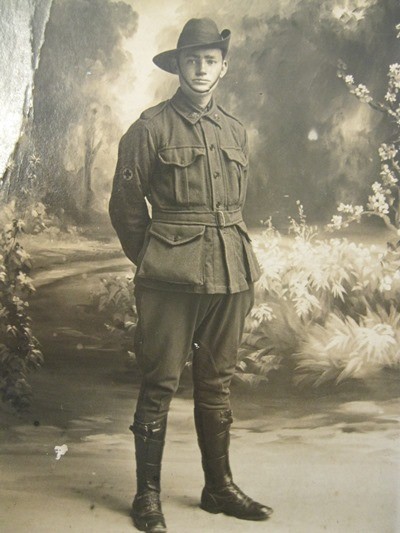
Studio portrait of Private Henry Dyson Keenan. John Oxley Library, Accession No. 30151
The photograph of the young soldier above is part of a small collection of soldier photographic postcards which belonged to Private George Crigan Graham, a young farmer, from Dungay, near Murwillumbah, in Northern New South Wales, and which were donated to us recently (Accession 30151). Graham served with the 9th Infantry Battalion in France. Graham, himself, was an underage soldier at the time of his enlistment, being only 17 at the time. He gave his age as 21 years and 9 months.
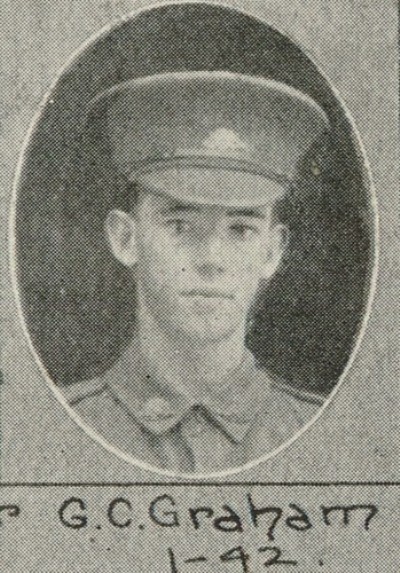
Private George Crigan Graham. Photograph from the Queenslander, 23 September 1916, p.23.
Looking at the photographs of these two soldiers it is difficult to determine their exact ages, although they both look awfully young. Henry Keenan, like George Graham, was also an under aged recruit, being only 16 when he joined the A.I.F. Recruitment officers, feeling the pressure of obtaining more troops, must have often turned a blind eye to the obviously under aged boys who were eager to enlist.
During the First World War the Australian army's enlistment age was 21, or 18 if the recruit had parental permission. Boys aged 14 to 17 could enlist as buglers, trumpeters and musicians, however many wishing to enlist as soldiers lied about their age and often gave false names so that their parents could not track them down.
The most famous Australian boy soldier was James Charles (Jim) Martin from Tocumwal, New South Wales, who enlisted in April 1915 when he was only 14. He gave his age as 18 and served at Gallipoli. On the 25th October 1915 he was evacuated from the Peninsula suffering from enteritis and died that night on the hospital ship, Glenert Castle, of heart failure at the age of 14 years and 9 months. He is believed to be the youngest Australian to die on active service.
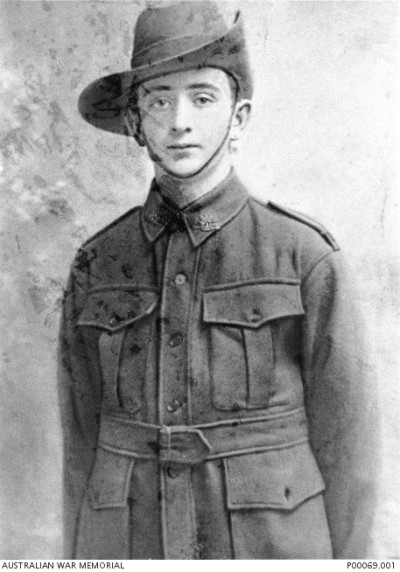
Jim Martin, Australian War Memorial photograph, P00069.001
Henry Keenan, from Fremantle, Western Australia, stowed away on the troopship Warilda on the 17th October 1915 and spent 8 months in Egypt before enlisting at Tel el Kebir on the 22nd April 1916. He gave his age as 18½, although he was only 16. The reverse of the photograph of Keenan bears this inscription:
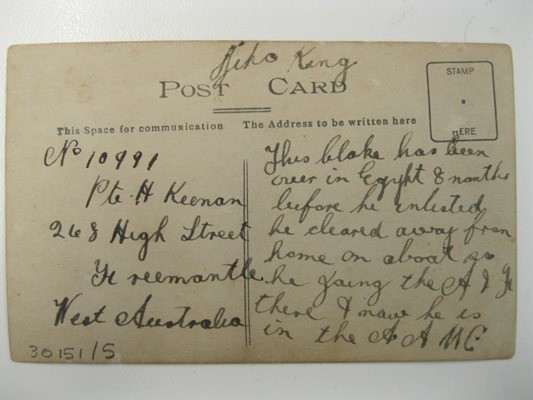
Prior to his service in World War I Keenan had been a member of the Royal Australian Naval Reserve. In 1911 the Australian Government introduced a compulsory training scheme which provided for 6 years elementary military training for boys between the ages of 12 and 18. This may have given him a taste for the military life. Before running away to sea he worked as a runner for the Sunday Times newspaper in Perth. It appears to have been no secret that he had run away to join the army as shown by this article and photograph which appeared in the Sunday Times, Perth, on the 30th July 1916.
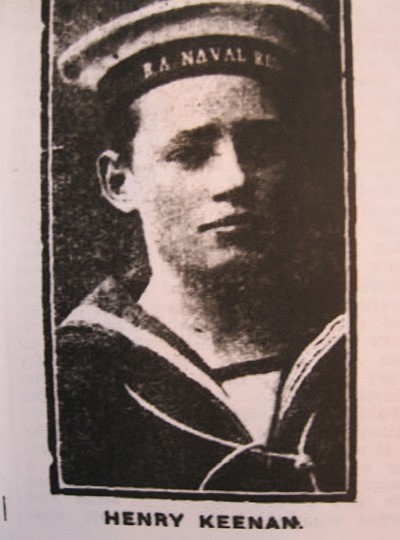
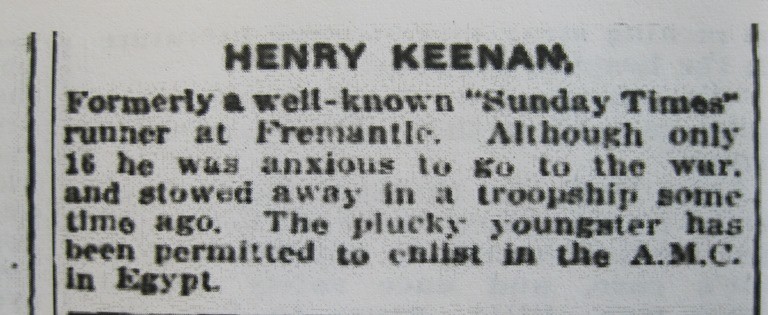
"Sunday Times" (Perth), 30 July 1916, p.14.
Keenan was posted to the 3rd Australian Auxiliary Hospital located in Dartford, England, which specialised in the treatment of soldiers with war-related nerves and neuroses. Fortunately he never experienced any front line action and eventually the military authorities caught up with him. He was returned to Australia on the ship Euripides in March 1918 and discharged from military service. His service record is annotated "Under age. Discharged without pay". He did however receive the British War Medal in recognition of his service. After returning to Australia he worked as a wharf labourer in Fremantle and died in 1960. He does not appear to have married.
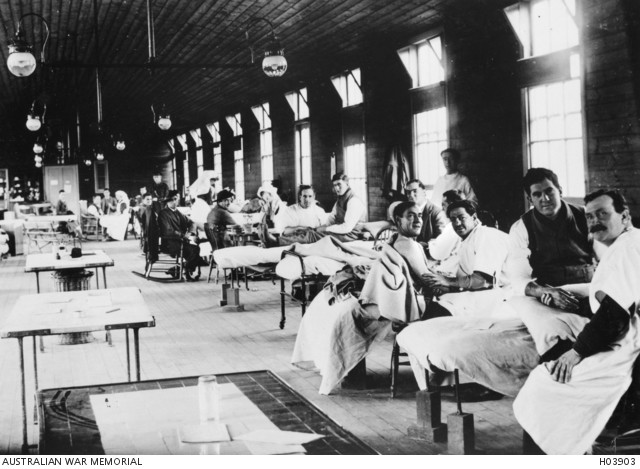
Patients and staff at the 3rd Australian Army Auxiliary Hospital in Dartford, England, 1918. Australian War Memorial, ID Number H03903
Presumably the impetus which drove these young boys, and older ones for that matter, to enlist was a sense of adventure and the chance to see the world. However author, Dr Maxwell Waugh in his publication Soldier Boys: the militarisation of Australian and New Zealand schools for World War I (Melbourne Books, 2014), argues that there was more than youthful enthusiasm at play.
Waugh presents the theory that the majority of the young men, and boys, who joined the A.I.F. during World War I were the product of a harsh compulsory military training scheme which operated in the schools and in the Citizen Military Forces, and which indoctrinated them in patriotism, preparing them to be used as cannon fodder at Gallipoli and on the Western Front. Waugh states that Australia was in effect a vast military training camp for the British Empire, providing a ready made army of fit and disciplined patriots ready to spring to the defence of the mother country. Waugh points out that no such system of compulsory training existed in Britain or any other part of the Empire, except New Zealand, at this time.
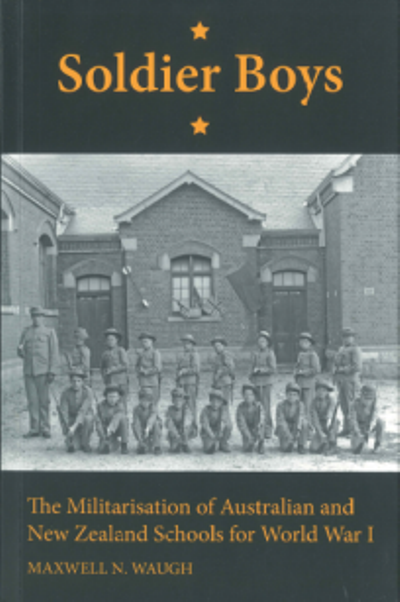
Waugh, Maxwell N., "Soldier Boys: the militarisation of Australian and New Zealand schools for World War I, Melbourne: Melbourne Books, 2014. State Library of Queensland, Call No. 940.40994 2014.
Whatever their reasons for enlisting it is a tragic fact that many under-aged boys were caught up in the horror of World War I, on both sides of the conflict. From ancient times to the present day stories of boy soldiers evoke a special sadness as they are tales of childhood's lost and the destruction of youth and possibility. One can only hope that Henry Keenan returned to Australia relatively unscathed from his travels and adventures during the Great War.
Lynn Meyers, QANZAC100 Content Curator
Comments
Your email address will not be published.
We welcome relevant, respectful comments.